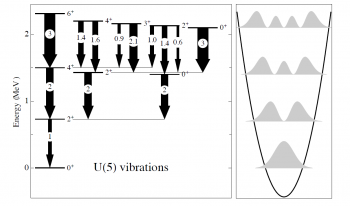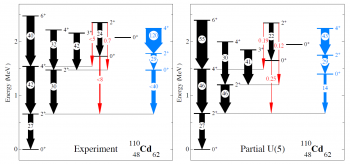Theoretical work involving researchers from Ganil, the University of Huelva in Spain and the Racah Institute of Physics in Israel, confirms the vibrational nature of cadmium-110, reproducing experimental observations that called this nature into question. Since the 1970s experiments have revealed the existence of non-vibrational states called "intruder" states. The new theoretical results, which are being extended to all even isotopes of cadmium, therefore solve a problem that is several decades old and has been highlighted by the publisher of the journal Physical Review C.
Cadmium isotopes, always containing 48 protons but different numbers of neutrons, have long been textbook examples for describing a particular mode of excitation of the atomic nucleus, namely the vibration. There are actually several ways to excite a nucleus, in particular through vibration and rotation. However, since cadmium nuclei are not deformed, i. e. have a rather spherical shape, rotation is prohibited in quantum mechanics. They are therefore widely studied for their vibrational character and vibrate at specific frequencies around their spherical equilibrium form. In analogy with the one-dimensional quantum oscillator (shown to the right of Figure 1), this description results in a vibrational model of the atomic nucleus with a characteristic pattern of excitation levels and decay paths (see Figure 1 on the left).

Figure 1: On the right, the potential energy of a one-dimensional quantum oscillator and the probability densities of the wave functions of the first four states and, on the left, the excitation levels and their decay paths of an ideal vibrational nucleus, corresponding to a five-dimensional quantum oscillator.

Figure 2: The theoretical model, shown on the right, reproduces the properties of the experimentally measured states of cadmium-110, shown on the left.
However, this ideal representation of cadmium nuclei as "spherical vibrators" was undermined since the 1970s by the experimental observation of states of low excitation energy whose properties (energy and decay paths) could not be reproduced in the context of the vibrational model of the atomic nucleus. These "abnormal" states fall into two categories: states whose vibrational character is well known but whose paths of decay are not as predicted (red transitions in the figure) and non-vibrational states, called "intruders" (blue states and transitions in Figure 2).
Many theoretical studies have unsuccessfully attempted to reconcile the vibrational nature of cadmium nuclei, characterized by the black states and transitions in the figure, with the particular properties of the other excited states observed (in red and blue). This has now been done with this study, as shown by the comparison proposed in the figure: not only are vibrational states with "abnormal" decay properties correctly reproduced, but the proposed new theoretical approach indicates that the vibrational states only slightly mix with "intruder" states.
This work, which solves a problem that has existed for several decades, has been the subject of "Rapid Communication" as well as a reader’s suggestion from the editor of Physical Review C.
DOI: https://doi.org/10.1103/PhysRevC.98.031302
Contact : Piet Van Isacker,
Partners : Ganil, , the University of Huelva, Spain and the Racah Institute of Physics, Israel
• Structure of nuclear matter › Atomic nucleus
• GANIL • Institute of Research into the Fundamental Laws of the Universe
